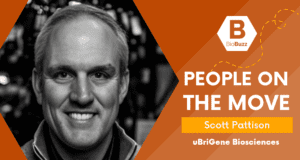
5 Questions with Kurt Elam, Senior Director, Sales & Marketing for LabOwl
“5 Questions With…” is a weekly BioBuzz series where we reach out to interesting people in the BioHealth Capital Region to share a little about themselves, their work, and maybe something completely unrelated. This edition features 5 Questions with Kurt Elam, Senior Director, Sales & Marketing for LabOwl.
Kurt Elam joined ACC/Lab Owl in 2017 with 20+ years of specialty biopharmaceutical experience, focused primarily on oncology, infectious disease, and critical care/ICU medicine. He has overseen and managed the successful launch of over 16 new FDA approved products/compounds or new indications, and worked to gain formulary approval in managed care organizations, thereby improving access for patients.
Prior to joining Lab Owl, Kurt worked with a number of biopharma companies, including Schering‐Plough, Astra‐Zeneca, EMD Serono, Amylin, and Actelion. He has a BA degree from the University of Virginia.
1. Tell us a little about your career path in BioHealth and what brought you do Lab Owl/Automated Control Concepts, Inc.
My career after my graduation from The University of Virginia has involved a number of twists and turns, and ups and downs, depending on the economy in some cases, my desire to pursue something I was more passionate about, or buyouts and mergers in others. Looking back on it, I see it in 3 distinct chapters thus far.
The first chapter was in agency advertising sales and account management and broadcast advertising with NBC and CBS affiliates in a number of East Coast cities. Then, after my father’s very difficult and ultimately losing battle with cancer, I realized I wanted to do something more meaningful with my sales career, so I switched industries and began my long career in biotech sales and marketing in 1999 joining the Oncology division of Schering-Plough.
This was the beginning of my second career chapter. During this 18 year period, I worked many different companies ranging from large pharmaceutical companies, like Astra Zeneca, Schering, and Eli Lilly, to mid-size biotechs like EMD Serono, to small and start-ups companies like Amylin, Actelion, and Strativa. Most of my time was focused in oncology and infectious disease, but I also managed hospital, critical care/ICU accounts, endocrinology, and a few other specialties.
I successfully organized and managed some very large territories and regions, and was very passionate about most of the breakthrough medications and therapies I was selling, knowing what a difference these treatments meant for patients. I especially loved launching new treatments and drugs, and in fact, of the 15 drugs I sold during my career, 12 were newly approved treatments or new FDA indications.
I also much preferred working for smaller, sharper, more nimble biotechs vs. the big pharma’s. They were more innovative and developed more breakthrough medications, but also offered you more of a voice, with a better corporate culture, and more opportunities for growth. However, the problem with working in biotech is when a small company is very good and has a strong portfolio of drugs in a particular therapeutic area, they are a target for takeover by a big pharma company.
And that’s exactly what happened with the last 4 companies I worked for. And that’s a very tough roller coaster to be on…over and over again. So, I finally knew it was time for a change, and I sought to take my biotech and sales career and experience in a different, and hopefully more stable direction.
That’s when I was approached by a recruiter about an opportunity to move into the bioprocessing and lab automation world of biotech and pharma helping to launch a new division called Lab Owl for a well-established system integration engineering firm, Automated Control Concepts, Inc. (ACC).
I was excited about the chance to work with the scientists in their early pre-clinical stage research on new compounds and treatments vs. Physicians and hospitals post-drug approval. I also was very drawn to ACC because they are a very successful small firm with a great reputation in the health sciences field with a very welcoming and close-knit corporate culture. So, in 2017, I joined Lab Owl/ACC and thus began the third chapter of my career.
2. Please introduce Lab Owl/Automated Control Concepts, Inc., and the services/applications you offer.
Lab Owl is the newest division of ACC and was launched in 2018. ACC has been in business since 1983 and is headquartered in Neptune NJ. They are an engineering firm focused on systems integration and automation and have been involved with life sciences companies, large and small, since their beginning…and were focused particularly in GMP manufacturing facilities for these biopharma companies. The Lab Owl division was born out of a project that ACC was involved in with the then Medimmune division of AZ.
While working on their new GMP manufacturing facility in Frederick, Md, they were called in to assist the scientists and engineers in Medimmune’s Process Development lab in Gaithersburg. They already had an existing bioreactor control and information system in place from another company, but it was too restrictive and inflexible and wasn’t meeting the needs of the 30 scientists working in this lab.
So our engineers went in and met with their scientific team, and over the course of a year or so of meetings, we developed a customized system that met all the needs of each of the scientists, who were working in teams of 5 and all had different goals but needed keep their data separate from the other groups, yet needed to also be able to share that data as required.
That unique and powerful system that was then called Biostation, is the first version of what is now Lab Owl. Lab Owl™ is a flexible, fully integrated, remote access bioreactor control and information system for cell culture, fermentation, regenerative medicine, cell and gene therapy applications.
Lab Owl features an easy-to-use interface for bioreactor automation and process control that is highly adaptable and has been leveraged in applications ranging from development labs operating bench-top parallel bioreactors to pilot plants and manufacturing operations. It is both a hardware (controller unit) and software solution. Lab Owl can be deployed to meet the specific needs of the company we are working with. For example, if a company is building a new lab or expanding their labs, they will most likely need both the controller units as well as the supervisory software system.
Our system is built on an open platform vs. a proprietary closed system. Meaning, our system can integrate with and control any other brand of controller units, other lab analyzers, as well as any brand, style, or size bioreactors… including glass, single-use/disposable, or stainless steel. This is rare in the bioprocessing industry, as most systems don’t work this way and are highly inflexible.
This open platform is especially valuable to companies who have old equipment from different manufacturers, but the control software is outdated and not meeting the needs of the researchers as they develop their process over time, or if a company has purchased used equipment that usually comes with no control software.
Lab Owl can be the ideal solution for these companies as our software can be integrated with these control units and provide a cutting edge, state of the art elegant control and information solution to the scientists, saving the company from having to replace all the older controllers and an enormous expense that many small and start-up biotech and CDMO firms might not have.
We truly listen to the individual needs of each of our customers and offer them a customized solution to meet their specific needs now, and into the future. We pride ourselves on the many long-term relationships we have with our customers. We see them as partners from the outset, and our work with them is truly consultative vs. transactional.
3. What are the most common challenges that your clients bring to Lab Owl/Automated Control Concepts, Inc.?
As I described in the previous question, we have found thus far that each company we work with brings new and unique needs and goals to us, and provides us with new challenges to meet and overcome. For example, vaccine researchers have very different automation and control requirements than scientists focused on mammalian cell lines or cell and gene therapy/CAR-T research.
Being a member of the Advanced Regenerative Manufacturing Institute (ARMI) is a great example of working with scientists and companies whose needs are totally unique. They work in much smaller volumes (usually less than 1L), than is typical in most labs (3 to 10L or greater) and often have unique bioreactor types like scaffolds or large Petri dishes.
So we have adapted our system to allow these companies the fine controls and automation they need to grow their tissue, ligaments, bone, or organs, and integrated unique sensing capabilities that are required to allow these researchers to know how their experiment is progressing.
We also partner with other companies like Scientific Bioprocessing, Inc (SBI) that are experts in sensing technologies to bring these capabilities to our customers and incorporate that into our Lab Owl system. We also partner with Bellco who makes bioreactor vessels so we can offer an end to end solution to companies seeking to ease the purchasing process.
We are always updating our software and adding new features depending on the needs of our customers. We then make all those updates available to all our existing companies, so as the needs and research of those companies evolve and change, our Lab Owl software will have all the capabilities they require as they grow and move towards pilot-scale and GMP manufacturing.
4. Where do you see Lab Owl/Automated Control Concepts, Inc. in the next 3 years?
We’ve come a long way in the two years since launch, and I see us continuing our growth each year and gaining more market and brand recognition, giving us more opportunities to bid on more projects, both large and small. Our biggest challenge is that name and brand recognition as we’re competing against very large international companies like Thermo Fisher, Sartorius and others, and most of the scientists and lab engineers we meet have experience working on one of these larger branded systems.
So that familiarity is a big hurdle to overcome as we talk to these scientists and work to convince them that our system is truly superior in many ways to what they’re used to. But each year we are growing and gaining more traction and recognition in the market, and I know that’s going to continue each year going forward.
5. What songs would you put on the playlist of your life?
RThis is a very interesting question, because for me, like some other people, music is such a huge sense memory….I can usually hear a song and it will take me back to a very specific time and moment in my life. It’s very powerful. My family and friends are often shocked at the specificity of my memories when I hear a particular song…so this list could be very long!
I’ll try to edit it down to particular decades or periods in my life and people…
Childhood—my father loved classic jazz singers and bands and Great American songbook artists… so from him:
Frank Sinatra—Summer Wind/In the Wee Small Hours of the morning.
Nat King Cole—Route 66 and Unforgettable
My Mom was more into Motown and early Rock n Roll singers and performers… so from her:
The Supremes—Baby Love or just about any of their songs
Fats Domino—Blueberry Hill
Johnny Mathis—anything… but especially his Christmas album.
My early memories from the 60’s…
The Beatles—Twist and Shout
The Partridge Family (yes, I said it) — I Think I Love You…and lot’s more, of course.
The 70’s was a wide range like…
Bill Withers—Lean on Me
Boston—More than A Feeling
The Commodores—anything
The Cars (early new wave) first album—Let the Good Times Roll
Blondie—Heart of Glass
Queen—Bohemian Rhapsody.
Also, early Elton John and Billy Joel—like Don’t Let the Sun Go down on Me (a definite favorite), and New York State of Mind. Even some dance/disco stuff by Earth Wind and Fire—September, ABBA—Waterloo, and Donna Summer—Sunset People. Yep… I said a wide range.
Then in the 80’s and my college and early career life, I was more into groups like REM and U2—especially their first few albums, Murmur for REM and U2—esp. Joshua Tree. I liked a lot of new wave like Modern English-Melt with You, The Cure—Friday I’m In Love, The Police—Ghost in the Machine/Synchronicity, The Go-Go’s—We Got the Beat and many others.
But I also grew up with Madonna and loved her first album with Holiday and I’m Burning Up, among others. Later 80’s I was into groups and singers like 10,000 Maniacs—About the Weather, George Michael—Faith, Tracy Chapman—Fast Car… and many others.
The 90’s through today is a huge blend of music from favorites from my past that I’ve already mentioned and still love and listen to, and some newer groups and singers like Coldplay, Pink, Green Day, and many, many more.
Thank you to Kurt Elam for participating in the ‘5 Questions with BioBuzz’ series and stay tuned for more interviews with others from across the BioHealth Capital Region and beyond.




